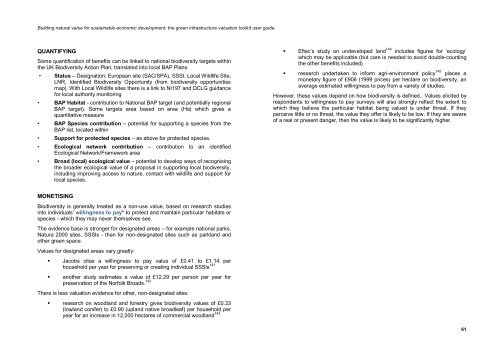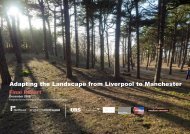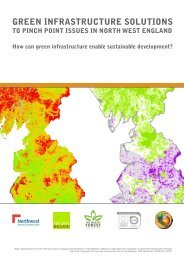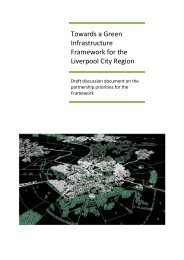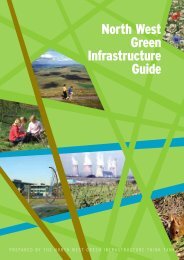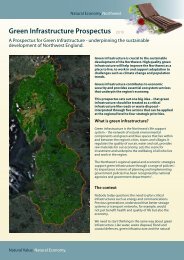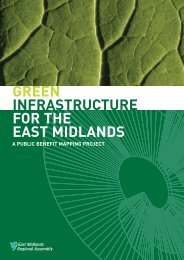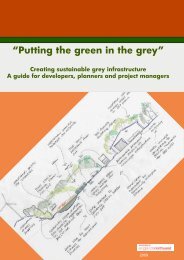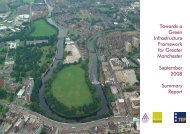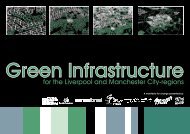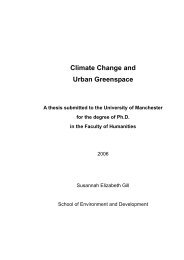The green infrastructure valuation toolkit user guide
The green infrastructure valuation toolkit user guide
The green infrastructure valuation toolkit user guide
You also want an ePaper? Increase the reach of your titles
YUMPU automatically turns print PDFs into web optimized ePapers that Google loves.
Building natural value for sustainable economic development: the <strong>green</strong> <strong>infrastructure</strong> <strong>valuation</strong> <strong>toolkit</strong> <strong>user</strong> <strong>guide</strong><br />
QUANTIFYING<br />
Eftec’s study on undeveloped land 144 includes figures for ‘ecology’<br />
which may be applicable (but care is needed to avoid double-counting<br />
Some quantification of benefits can be linked to national biodiversity targets within<br />
the other benefits included)<br />
the UK Biodiversity Action Plan, translated into local BAP Plans.<br />
• Status – Designation: European site (SAC/SPA), SSSI, Local Wildlife Site,<br />
research undertaken to inform agri-environment policy 145 places a<br />
LNR, Identified Biodiversity Opportunity (from biodiversity opportunities<br />
monetary figure of £906 (1999 prices) per hectare on biodiversity, an<br />
map). With Local Wildlife sites there is a link to NI197 and DCLG guidance<br />
average estimated willingness to pay from a variety of studies.<br />
for local authority monitoring<br />
However, these values depend on how biodiversity is defined.. Values elicited by<br />
• BAP Habitat - contribution to National BAP target (and potentially regional<br />
respondents to willingness to pay surveys will also strongly reflect the extent to<br />
BAP target). Some targets area based on area (Ha) which gives a<br />
which they believe the particular habitat being valued is under threat. If they<br />
quantitative measure<br />
perceive little or no threat, the value they offer is likely to be low. If they are aware<br />
of a real or present danger, then the value is likely to be significantly higher.<br />
• BAP Species contribution – potential for supporting a species from the<br />
BAP list, located within<br />
• Support for protected species – as above for protected species.<br />
• Ecological network contribution – contribution to an identified<br />
Ecological Network/Framework area<br />
• Broad (local) ecological value – potential to develop ways of recognising<br />
the broader ecological value of a proposal in supporting local biodiversity,<br />
including improving access to nature, contact with wildlife and support for<br />
local species.<br />
MONETISING<br />
Biodiversity is generally treated as a non-use value, based on research studies<br />
into individuals’ willingness to pay* to protect and maintain particular habitats or<br />
species - which they may never themselves see.<br />
<strong>The</strong> evidence base is stronger for designated areas – for example national parks,<br />
Natura 2000 sites, SSSIs - than for non-designated sites such as parkland and<br />
other <strong>green</strong> space.<br />
Values for designated areas vary greatly:<br />
Jacobs cites a willingness to pay value of £0.41 to £1.14 per<br />
household per year for preserving or creating individual SSSIs 141<br />
another study estimates a value of £12.29 per person per year for<br />
preservation of the Norfolk Broads. 142<br />
<strong>The</strong>re is less <strong>valuation</strong> evidence for other, non-designated sites:<br />
research on woodland and forestry gives biodiversity values of £0.33<br />
(lowland conifer) to £0.90 (upland native broadleaf) per household per<br />
year for an increase in 12,000 hectares of commercial woodland 143<br />
61


